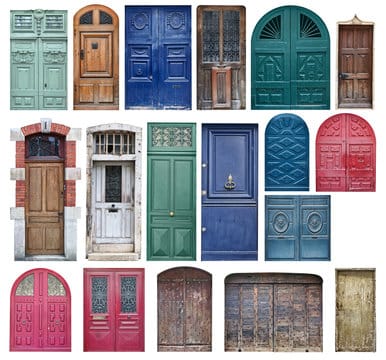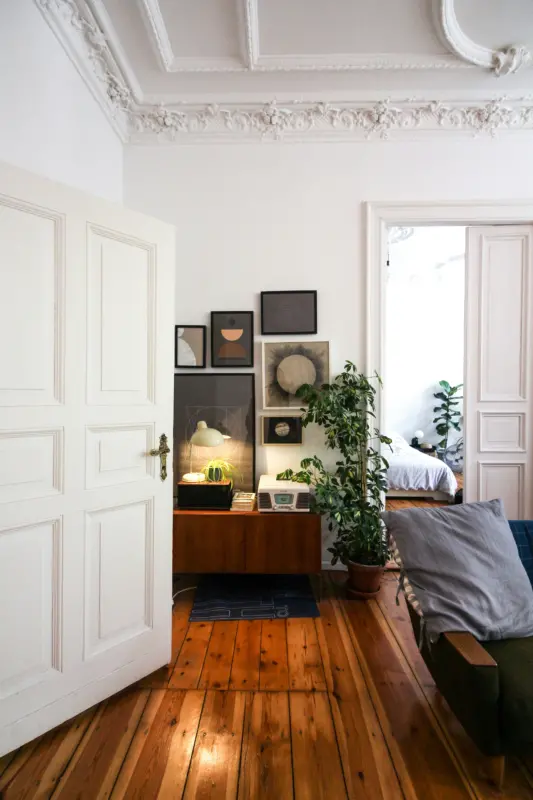Nothing emphasizes the nobility of the interior as good as antique furniture. And the final touch, the final point in the decoration of the house, is made by “aged” doors.
How the effect of “aging” is achieved?
“Age” effect can be implemented on the door in several ways. The most popular ones:

Patination – This is an imitation of an oxide film that forms over time on products. The shades of patina vary widely, as does the color of the door enamel. Patination gives interior doors a special charm, turning them into a luxurious heritage of antiquity. There are two different approaches to this technique. Inexpensive, but outwardly attractive solutions are implemented with the help of special varnishes. Silver, golden, dark or bronze spraying covers the recesses of the slabs, the perimeter of the panels, moldings. Much more valuable than original handmade products, with 2-layer staining. The surface of such a door is covered with outwardly natural, but in fact – carefully formed by hand grinding, scuffs carved with wood patterns, and the “peeling” top layer of varnish reveals the lower contrast layer of enamel. White patinated doors, which came into fashion at the beginning of the 19th century with the spread of the Empire style, are highly valued. Due to the inaccessibility of hardware processing, the composition is applied to them completely manually. More often these are oak doors, its patinated wood is especially expressive and spectacular.

Craquelure. The slab is covered with a texture of cracks, similar to those present in old paintings. Cracking varnish helps to achieve this. Through the outer coating, the base is clearly visible – gold, burgundy, black or any other. Craquelure technology is often used when decorating doors in Provence, Empire, Baroque styles.
Brushing. The method got its name from the word “brush”. The main working tool is a metal brush, which removes the top layer of wood, exposing annual rings. This is followed by grinding – to get rid of burrs and other roughness, after which the slabs is decorated with paint, varnish or stain. Ideal for brushing are pine or oak products. In maple, beech and birch, the slabs are not so pronounced, so the processing does not give the desired effect. And brushing is completely contraindicated for MDF doors. A combination of methods is also possible. So, in solemn compositions, doors treated with gold or bronze patina are complemented with craquelure.
Styles of the “Aged Doors”

Aged doors are not universal solutions. Their external elegance and richness of shades require style and color matching of other attributes of the room. They are most harmonious in classical interiors, to which they add charm, increasing prestige and aesthetics. In a Provence setting, this is a sophisticated and outwardly simple product. The dark patina fits perfectly on the whitewashed background, giving the sash expressiveness and relief. A country-style door is a real decoration of a country house. The country interior is characterized by an abundance of metal details that go well with patinated wood. Boho style creates an amazing atmosphere, emphasizing the individuality of the owners of the house. The “antique” door gives texture to the design, emphasizing the character of the situation. The design of an aged door largely depends on the illumination of the room. Glazed fragments are appropriate in the hallway. Fans of the Middle Ages choose glass with stained glass. In a country house, where there is more space and light, glazing with separate framed windows with colorful patterns is suitable.

 All Interior Doors
All Interior Doors Prehung Doors
Prehung Doors Doors By Style
Doors By Style Doors By Room
Doors By Room Sliding Doors
Sliding Doors Doors By Color
Doors By Color Bi-Fold Doors
Bi-Fold Doors French Interior Doors
French Interior Doors All Exterior Doors
All Exterior Doors Steel Security Doors
Steel Security Doors Fiberglass Doors
Fiberglass Doors Wrought Iron Doors
Wrought Iron Doors Aluminum Windows
Aluminum Windows Vinyl Windows
Vinyl Windows Wood Windows
Wood Windows Tables
Tables Accessories
Accessories Magic Door Hardware
Magic Door Hardware Magnetic Door Hardware
Magnetic Door Hardware Entry Handle sets
Entry Handle sets Barn Door Hardware
Barn Door Hardware Pocket Door Hardware
Pocket Door Hardware Door Levers
Door Levers Magnetic Locks
Magnetic Locks Hinges
Hinges Bathroom Mirrors
Bathroom Mirrors Wall-Mounted Vanities
Wall-Mounted Vanities
















 Steel Security Doors
Steel Security Doors